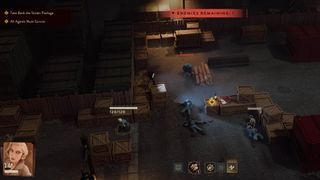12DOVE Verdict
Competent and stylish in its real-time strategy, The Lamplighters League puts an art deco spin on a simplified XCOM formula, but is let down by real-time segments that dilute and distract from its core offering.
Pros
- +
Completely drenched in its inter-war art style
- +
Pleasingly diverse roster
- +
Combo-based strategy promotes intricate combat
Cons
- -
Real-time segments just get in the way of turn-based setup
- -
Hard to balance enemy progression
- -
Maps are way too big
Why you can trust 12DOVE
There's a very good turn-based strategy game in The Lamplighters League. As your roster of Depression-era Agents swells in its attempt to halt an Indiana Jones-style apocalypse scenario, you'll find it on nearly every mission you go on. As you chain together combos of devastating punches, lob fire bombs to secure yourself an escape route, or simply nail that clutch 10% chance -to-hit to take down a dangerous enemy, this game will sing almost as loud as giants of the genre. It's just a shame that it has to fight to be heard over the noise of its distracting real-time segments.
Release date: October 3, 2023
Platform(s): PC, Xbox Series X
Developer: Harebrained Schemes
Publisher: Paradox Interactive
Under the direction of Locke, the last surviving member of the mysterious Lamplights League, you'll send your hastily-recruited collection of Agents across the world to hinder the efforts of three Scions – captains of industry and masters of lost religions who seek access to the mythical Tower of Babel in an attempt to redraw the world to their ideals. Cycling through the base-map-mission model repopularized by XCOM 2, you'll smash equipment, steal supplies, and rescue hostages as you try to hinder their progress at any cost.
Temple of Boom

No matter the nature of your current task, you'll approach each mission in one of two ways, with real-time exploration giving way to turn-based combat. Each of three Agent archetypes has a different means of interacting with the world in real-time: Sneaks hit stealthy single-target takedowns; Saboteurs fry foes with shock traps; Bruisers charge forwards, decking multiple enemies at once.
Every tool has the same overall goal – to thin the enemy herd and make the eventual turn-based fight a little easier for your side with the slow-motion thump of a charge or the crackle of an enemy frying in a trap. But even when you pull them off flawlessly, they can be indicative of the limited ways in which real-time and turn-based moments interact. Once you've gone loud and triggered the enemy guards into turn-based action, you'll want to make use of multiple important combat tools that require your Agents to be close together.
But real-time takedowns encourage your team to split up – Sneaks want to leverage their stealth to get distant kills without lugging the rest of the party around with them. Bruisers go very loud, very quickly, charging ahead as they kick off a fight. More than once, I fell foul of the detection systems and ended up with a team spread across maps that feel far too large for the kind of strategy gameplay that The Lamplighters League is aiming for.
Dishonorable

Those real-time sections feel like they're supposed to set up for a full stealth game. There are even hints of a more detailed system; if a guard catches a glimpse of you, you'll see exactly where they're going to investigate; if you sprint, the noise of your fast-moving feet will attract attention. Play things right, and it's possible to sneak through to an objective without triggering turn-based combat, slipping away before the guards even know you've been there.
Sadly, The Lamplighters League does little to encourage these ideas: light and shadow don't affect how likely guards are to spot you; other than a deadly trap, there's nothing to draw enemies away from their posts; enemy bodies can't be hidden, and when they're inevitably discovered, guards scatter off their patrol routes almost at random, throwing any attempt at a plan into disarray. I keep finding myself hoping for a more fleshed-out stealth experience, even as I surreptitiously flee the scene of my latest heist.

"The ability to swap between characters at will means that it's easy to get the most from the Action Point system"
While it doesn't knit nicely with the real-time efforts, The Lamplighters League's strategy gameplay is much more successful. The ability to swap between characters at will means that it's easy to get the most from the Action Point system, and it's easy to use tools in tandem to create lengthy chains of moves. Ingrid, a Bruiser, refunds Points on kill, so after whittling multiple units down with my other characters, I could make use of the generous range of The Lamplighters League's 'move-to-hit attacks to take down a suite of enemies in a single turn.
Those tools marry together on defense as well as offense. With my back firmly planted on the wall in one story mission, I hunkered down beneath natural cover and combined a defensive field with a cloud of smoke. Heavily protected, I could whittle down any foes foolish enough to step into pistol range. Fire bombs and environmental hazards create choke points or walls of flame that offer satisfying crowd control, and signature abilities allow you to mow down funneled-together groups of enemies. Decoys draw fire while you make daring escapes, and makeshift shields allow you to send advancing enemies flying backwards.
There are a lot of tools to play with in each characters' basic kits, but The Lamplighters League gives you the chance to switch things up even further. 'The Undrawn Hand' is a mysterious deck of playing cards that generates random bonuses at the end of each mission. My Bruiser gained a push ability to let me shove enemies around the map. I gave my melee assassin a ranged attack to offer some extra versatility in fights. My quick-shooting Saboteur has skills to enhance every shot he hits. Between the Hand and more conventional upgrade paths that boost your inherent skills, there are a lot of ways to push each character's strengths to offer an edge, even if weapon upgrades are disappointingly elusive.
Tick tock, Locke

As you attempt to thwart the Scions, their progress is documented by Doomsday Clocks above the map from which you plan your next move. As their schemes advance past markers on their individual clocks, each set of missions gets more difficult, upgrading basic enemies. It's an obvious tool, but surprisingly effective at dragging your attention across the map. Different missions will advance each Scion by different amounts, but you'll be forced to weigh that progress up against missions that grant you supplies or new recruits. The triple-threat of three opponents means that the world map is a delicate balancing act, and it didn't take long before I was starting to feel overwhelmed by the number of choices I had to make.
You'll make your plans from a secret Mediterranean hideout from which League's Agents can purchase supplies and upgrades, all while clustered around Locke's war table. It's a tableau dripping with The Lamplighter's League's art deco style, a diverse but chaotic roster of interwar stereotypes crammed in in a manner reminiscent of a renaissance painting belying those Depression-era vibes.
For that wild array of '30s archetypes, there's a pleasing chemistry to the League. From the femme fatale and the black market aviator to two characters that might have been lifted directly from '99's The Mummy and an occultist Parisian flapper, this might not be the most intricately woven range of character interactivity, but they'll quip good-naturedly back-and-forth both in and out of missions.


If you're looking for other games like The Lamplighters League, why not check our pick of the best strategy games.
While you'll rarely want to veer too far away from the Sneak/Saboteur/Bruiser trio, different characters do bring completely different strengths to bear. One of the two Bruisers I had access to at the start of the game, Ingrid, was all about close-quarters fighting, fists and feet flying to level anyone foolish enough to get close. But Judith, another Bruiser, offers defensive boosts instead. Lateef, a Sneak, moves fast and shoots straight, but his counterpart Celestine gets in close, attacking with a venomous dagger. I have my favorites, certainly, but whenever one of those is indisposed, it's easy enough to swap in an alternative without feeling as though you're losing out on a key part of your team.
When it's turn-based, The Lamplighters League is very good. It rides a fine line, simple enough to never find you lost in a fog of decision paralysis but complex enough to generate the emergent storytelling that games like XCOM and Invisible Inc thrive on. Upgrades let you paper over the weaknesses or enhance the strengths of your favorite characters, and environmental hazards and your own supplies let you shape the battlefield around yourself. But the real-time accessory to the conventional turn-based strategy disappoints, occasionally shining but mostly diluting and distracting from an experience that would be better without it. The Lamplighters League might not stand fully toe-to-toe with the strategy juggernauts of recent years, but it's a plucky competitor - just as long as you don't get bogged down in its attempt to set itself apart from the games it's trying to emulate.
Disclaimer
The Lamplighters League was reviewed on PC, with code provided by the publisher.
More info
| Genre | Strategy |

I'm GamesRadar's news editor, working with the team to deliver breaking news from across the industry. I started my journalistic career while getting my degree in English Literature at the University of Warwick, where I also worked as Games Editor on the student newspaper, The Boar. Since then, I've run the news sections at PCGamesN and Kotaku UK, and also regularly contributed to PC Gamer. As you might be able to tell, PC is my platform of choice, so you can regularly find me playing League of Legends or Steam's latest indie hit.

Despite Zelda: Majora's Mask basically being a horror game, one of its key devs didn't think its creepiest features were scary at all: "People on the team were like 'whoa!'"

Corsair exec says GTA 6 is coming to PC in early 2026 and then quickly un-says that

This puzzle game has done the impossible: waiting around for something to happen has never, ever been this fun
Most Popular





